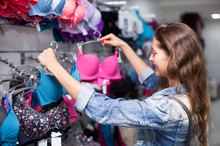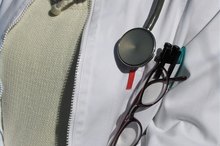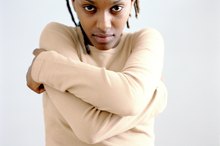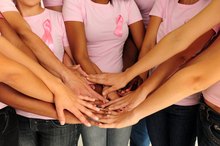Breast Growth in Teenagers
When your child reaches the preteen and teenage years, she may start to have some questions about her breasts. She's probably noticed that breasts get a lot of attention in advertisements, but it's important that she knows they serve a much more important function than decoration: they allow a woman to feed her baby. She may be left wondering when exactly to expect them and what normal breasts should look or feel like.
Onset of Growth
Your daughter's breasts may start to grow as early as age 8 or as far down the line as age 13, says the Kids Health from Nemours. Even so, some girls develop faster than others, meaning that if she started developing breasts early, she may still be developing when her friends’ breasts have already stopped growing. All girls start to develop breasts in the same way, regardless of when development began. Your child's ovaries enlarge and a female hormone called estrogen starts to circulate throughout her bodies, which ultimately forms small raised lumps on the chest known as breast buds. At the same time, the dark skin around her nipples will get larger, says the Ohio State University Medical Center.
- Your daughter's breasts may start to grow as early as age 8 or as far down the line as age 13, says the Kids Health from Nemours.
- Your child's ovaries enlarge and a female hormone called estrogen starts to circulate throughout her bodies, which ultimately forms small raised lumps on the chest known as breast buds.
Normal Breast Development
Signs of Breast Development
Learn More
After breast buds have formed and around your daughter's first period, her breast tissue eventually enlarges from the development of glands and fat. Next, her breasts may change in shape rather than size, sometimes happening slowly or sometimes quickly, notes Planned Parenthood 3. In the last stage of breast development—typically at about age 17 or 18, but sometimes in a woman's early 20s— her breasts will round out until only her nipples are raised.
Variation of Shapes and Sizes
Once your child's breasts are fully developed, she may notice hers don't look the same as her friend's breasts. Heredity and weight are big factors that determine a teen’s breast size. If, for example, you have smaller breasts and you are thin, your daughter is less likely to have large breasts than your daughter's rounder friend whose mother has large breasts, according to Kids Health. Contrary to what some of her friends and television commercials say, she needs to understand that she can’t alter the size of her breasts by taking any pills or spreading on any creams.
- Once your child's breasts are fully developed, she may notice hers don't look the same as her friend's breasts.
Understanding These Changes
Breast Bud Development Signs
Learn More
Your daughter's breasts may not develop the way she wants them to, says PBSKids.org. For example, one may grow faster than the other--even though they’ll likely even out over time—and they may become pointy before they become round and full. She may also feel weird changes like lumps and tenderness at different times, but most of the time that’s normal, says PBSKids.org. She should talk to you or her doctor if she's worried, to help calm any concerns she may have.
- Your daughter's breasts may not develop the way she wants them to, says PBSKids.org.
- She may also feel weird changes like lumps and tenderness at different times, but most of the time that’s normal, says PBSKids.org.
Time for a Bra
Wearing a bra can help protect your child's breast tissue, keep her breasts supported and smooth out her silhouette, says the Kids Health. You can buy a wide variety of bras, including sports bras for when she's exercising, underwire bras for extra support, natural soft-cup bras for comfort, padded bras for extra size and minimizer bras for size reduction, says Kids Health. Talk to a lingerie department employee at your local department store to be sure that you buy a bra that is right for your daughter's breast size.
Related Articles
References
- PBSKids.org: Puberty, The Breast Years of Your Life
- KidsHealth: Breasts and Bras
- Planned Parenthood: Puberty for Girls
- Winocour S, Lemaine V. Hypoplastic Breast Anomalies in the Female Adolescent Breast. Semin Plast Surg. 2013;27(1):42–48. doi:10.1055/s-0033-1343996
- Cruz NI. Breast Asymmetry in Women Requesting Plastic Surgery of the Breast. P R Health Sci J. 2018;37(4):230‐238.
- Chen JH, Chan S, Yeh DC, Fwu PT, Lin M, Su MY. Response of bilateral breasts to the endogenous hormonal fluctuation in a menstrual cycle evaluated using 3D MRI. Magn Reson Imaging. 2013;31(4):538-44. doi:10.1016/j.mri.2012.10.022
- Kader T, Hill P, Rakha EA, Campbell IG, Gorringe KL. Atypical ductal hyperplasia: update on diagnosis, management, and molecular landscape. Breast Cancer Res. 2018;20(1):39. doi:10.1186/s13058-018-0967-1
- Hisham A. Juvenile Breast Hypertrophy: A Successful Breast Reduction of 14.9% Body Weight without Recurrence in a 5-Year Follow-Up. Case Rep Surg. Volume 2017, Article ID 3491012. doi:10.1155/2017/3491012
- Kayar R, Çilengiroğlu ÖV. Breast Volume Asymmetry Value, Ratio, and Cancer Risk. Breast Cancer (Auckl). 2015;9:87-92. doi:10.4137/BCBCR.S32789
- Reilley Ann F. Breast Asymmetry: Classification and Management. Aesthetic Surg J. 2006;26(5):596-600. doi:10.1016/j.asj.2006.07.006
- Cruz NI. Breast Asymmetry in Women Requesting Plastic Surgery of the Breast. PR Health Sci J. 2018 Dec;37(4):230-238.
Writer Bio
Christa Miller is a writing professional with expertise in massage therapy and health. Miller attended San Francisco State University to earn a Bachelor of Arts in creative writing with a minor in journalism and went on to earn an Arizona massage therapy license.









